
02-19: BOE Technology indicates that its Gen-6 flexible AMOLED production line in Chengdu has begun mass production and shipment; Samsung is reportedly left with excess production capacity for its OLED panels; etc.
Touch Display
LG G6’s successor is currently being referred to as “Judy” and has a “brand new design” compared to past phones in LG’s recent lineup. Judy will ship with a 6.1” 18:9 Full Vision display, and it is said to be LG’s first phone with an MLCD+ panel. MLCD+ has an RGBW matrix with white sub-pixels, and it has a brightness rating of 800-nits while also using 35% less power compared to IPS LCD tech. (VentureBeat, Android Central, CN Beta)
Apple allegedly plans to fill up the notch on top of the iPhone X display, only leaves camera lens and speaker hole, so that the screen ratio could increase to 99%, to provide the best augmented reality (AR) experience. Apple expects to launch this product as soon as 2019. Samsung Display and LG Display have already received design concept from Apple, wanting to develop a method to drill hole at the middle of a flexible OLED panel. (EE Focus, EE World, Laoyaoba)
BOE Technology indicates that its Gen-6 flexible AMOLED production line in Chengdu has begun mass production and shipment, and the yield rate is improving. Its Gen-6 Mianyang flexible AMOLED production line expects to begin production in 1H19, and Gen-8 Fuzhou production line ramping up is smooth, and expects to enter full production in 1H18. (Laoyaoba, Sina)
Foxconn chairman Terry Guo indicates that the panel production fab in Wisconsin will begin construction as early as in Apr 2018. The investment activity has begun since end of 2017, and the first USD60M first phase construction has already started in Jan 2018. (Laoyaoba, NTDTV, CNA, Fox 6 News)
Samsung’s new patent with WIPO describes a device that features a mechanical joint on its back. It features a single screen capable of bending inward, though without the ability to have the two halves of the display perfectly flush with each other. (Android Headlines, Android Hits, CN Beta)
Samsung is reportedly left with excess production capacity for its OLED panels, after Apple slashed its production of the iPhone X. With Chinese OLED panel makers expanding production capacity, and screens from LG Display and BOE Technology on the way, OLED panels might be oversupply causing the costs to drop. IEK manager Lin Zheming indicates that the production value could drop more than 25%. (Laoyaoba, Apple Insider, Asia Nikkei, 9to5Mac, UDN)
Camera
Apple’s new invention may provide improved image quality for a small format factor (SFF) camera when using accessory lenses. SFF cameras may, for example, be used in mobile devices such as smartphones, pad or tablet devices, and may also be used in other devices such as laptop or notebook computers. Accessory lenses may be provided that attach to or mount in front of the SFF camera’s lens. (Laoyaoba, Digital Trends, Patently Apple)
Sony has developed a new backside-illuminated stacked sensor equipped with global shutter functionality with 1.46-million-pixel resolution. The sensor is able to read every pixel simultaneously thanks to its ‘stacked’ design, which comprises a top chip containing the active pixels, and below that a bottom chip which contains an analog-to-digital converter tied to each pixel in the photo-sensitive top chip. (CN Beta, Peta Pixel, Camera Jabber, Sony, DP Review)
Storage
According to TrendForce, the DRAM revenue for 4Q17 grew by 14.2% QoQ to a new high, and the DRAM revenue for the entire 2017 grew by 76% YoY. The main reasons are the rising mobile DRAM prices and opportunities provided by the year-end busy season and the releases of new flagship smartphones in 4Q17. Depending on density specifications, prices of mobile DRAM products rose by 5%~20% QoQ in 4Q17. (Laoyaoba, TrendForce, press, TrendForce[cn])
Sensory
Apple and its partners are reportedly “working hard on a world-facing solution” capable of scanning surroundings in 3D, similar to the TrueDepth system. Barclays expects that Apple will employ a “similar but tweaked TrueDepth sensor” on the rear of that future iPhone. Alternatively, or coupled with the sensor, Apple will use time-of-flight (ToF) calculations to bolster the data from whatever sensor it installs on the device. (Apple Insider, WCCFTech, Mac Rumors, Value Walk, CN Beta)
Battery
Led by mobile phones, small appliances and wearables, shipments of consumer electronics devices enabled with wireless charging rose 40% in 2017, compared to the previous year. In all, nearly 500M devices with wireless charging shipped in 2017, according to IHS Markit. (Laoyaoba, IHS Markit, press)
Connectivity
Huawei has announced today that Canadian carrier Telus is live-testing Huawei 5G equipment in Vancouver homes. The companies’ in-home testing is said to be the first of its kind in North America, bringing 5G from the “lab to the living room” and setting the stage for a future commercial launch of fixed 5G service in Canada. (VentureBeat, Huawei, CC Time)
ZTE has reportedly priced its hardware at roughly one-fifth the cost of European and Japanese competitors’ products and is using its growing Tokyo office to pitch Asian and South American companies. ZTE is working to win 5G contracts from Japanese carriers ahead of the 2020 Tokyo Olympics, which it expects “will become the world’s showcase for 5G technology.” (VentureBeat, Asia Nikkei, Sohu)
A new 5G connection test conducted by Finnish outlet Kauppalehti and wireless carrier Elisa showed 14 times better performance over 4G LTE in a real-world environment, having managed to consistently deliver speeds over 700Mbps. The setup used Huawei-made equipment compliant with the 3GPP’s Release 15 standard, the first implementable 5G specification completed in late Dec 2017. (Android Headlines, Metropolitan.fi)
Phones
The growth momentum in global smartphone market will remain weak in 2018 due to lower demand and less replacement purchases, says TrendForce. Faced with continuous rise in the costs of upstream components, downstream mobile phone vendors have to re-consider the pricing or adjust the specification of end-products to cope with the cost pressures. The distribution of market share among the major players is expected to remain generally the same as last year. Therefore, TrendForce estimates the global smartphone production for 2018 at around 1.5B units, a 2.8% annual growth only, down from previously expected 5%. (GizChina, TrendForce, press, TrendForce[cn])
Without any drivers of any advantages, GfK estimates that in 2018 China mobile phone market wholesale volume would be 449M units, a 4% decline on year, which indicates China mobile phone market is entering a phase of “standstill growth”. Gfk forecasts that 2018 China mobile phone market wholesale revenues would be about CNY1.09T, a 7.1% increase on year. The ASP would exceed CNY2500. (GfK, report, Laoyaoba)
According to IDC, the Indian smartphone market witnessed a healthy 14% annual growth with a total shipment of 124M units in 2017, making it the fastest growing market amongst the top 20 smartphone markets globally. China-based vendors further strengthened their positions in the smartphone category with the collective share of China-based vendors reaching 53% in 2017 from 34% a year ago. (IDC, press, Gizmo China, Qian Zhan, Tencent)
HTC’s President of Smartphone and Connected Devices Business, Chialin Chang, has resigned from his post. Chang chose to leave the company in order to further his personal career plan, and plans to set up an AI-based company in the near-future. (Laoyaoba, Digital Trends, HTC, Apple Daily, UDN)
Google CEO Sundar Pichai will highlight 14 states in US where it plans to increase its investments. The company plans to spend USD2.5B over the next several years to build new data centers. These investments will bring Google’s footprint to 21 states, with data centers in 6. (Engadget, CNBC, Google, Sina, Baijiahao)
Foxconn has said that it will keep its commitment of investing USD5B in Maharashtra, as outlined in a memorandum of understanding (MoU) signed in 2015. However, since then the company has not made any formal announcement of investment in the country or the state. The state industries minister Subhash Desai indicates that Foxconn might go back on its promise to invest in the state. (Laoyaoba, Apple Daily, LTN, China Times, Economic Times)
Turing Robotic Industries has filed for bankruptcy in Finland. The company promised an ultra-secure smartphone in 2015 with Android 5.1 but turned around and decided on Sailfish OS instead, only to keep on delaying production again and again then promise one outrageous upgrade after the other. (Laoyaoba, Engadget, SSS, Android Police, Extreme Tech)
UK-based Wiley Fox founded in Aug 2015 has positioned itself as a small company that operated on small margins, with a plan to sell powerful but low-cost Android handsets. The company has reportedly entered into administration. (SlashGear, TechCrunch, Engadget, Reddit, MICE Times)
Wearables
Withings, the French wearables company, was acquired by Nokia in 2017. It joined the company and came to be known as Nokia Health. However, Nokia could possibly end up selling its Digital Health business because the company has confirmed that it has begun a strategic review of the business to consider its options. (Ubergizmo, Nokia, East Day)
Internet of Things
Bang & Olufsen has announced a new partnership with Swiss digital audio company HiFiBerry that will allow DIY audio enthusiasts to easily transform their vintage B&O speakers into wireless audio workhorses. Called the Beocreate program, the new open source project features a custom DSP board that works as a four-channel amplifier. (The Verge, Digital Trends, HiFiBerry, East Day, CN Beta)
Google has announced that it intends to buy Xively from LogMeIn for USD50M, giving Google Cloud an established IoT platform to add to their product portfolio. Google has indicated it wants to use this purchase as a springboard into the growing IoT market, which it believes will reach 20B connected things by 2020. (TechCrunch, Google, LogMeIn, East Day, Sohu)
Alphabet’s Google has hired Injong Rhee, who recently resigned as Samsung Electronics’s chief technology officer, to lead its Internet of Things business. (VentureBeat, LinkedIn, Sina)
Microsoft has announced that its digital assistant, Cortana, will now work with IFTTT and a number of new smart home devices, such as the Ecobee, Honeywell Lyric, and LIFX. To set them up, just open Cortana on Windows 10 or launch the Cortana app and add the new products under the Connected Home menu. (The Verge, Microsoft, Baijiahao)
China is racing ahead in AI. Deep learning is getting a make over. AI is coming to Cannabis tech. CB Insights looks at 13 artificial intelligence (AI) trends reshaping industries and economies. (CB Insights, report)
Apple HomePod costs USD216 to build and generates thinner profit margins than other products like the Apple Watch and iPhone, according to analysis by TechInsights. Given the HomePod’s USD349 price, that USD216 cost suggests Apple is generating margins of about 38%. (Laoyaoba, Bloomberg, Mac Rumors, 9to5Mac, TechInsights, article)
Google will bring Nest Labs onto its hardware team in an effort to integrate the smart thermostat business with Google’s other smart home products. Nest, which has been operating independently from Google for the past two years, will no longer exist as a separate unit under Alphabet’s “other bets” group of projects. (Laoyaoba, Gizmodo, The Verge, Green Tech Media, CNET, Google)
Waymo, a unit of Alphabet Inc., got a permit in late Jan 2018 from the Arizona Department of Transportation to operate as a Transportation Network Company, according to Ryan Harding, a spokesman at the state agency. The designation lets Waymo’s fleet of driverless Chrysler Pacifica minivans pickup and drop off paying riders in Arizona through a smartphone app or website. (CN Beta, Business Insider, Bloomberg)


















